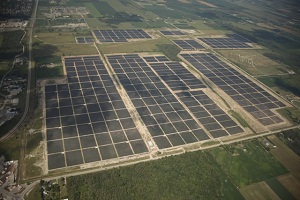What Colorado can learn from Ontario’s clean energy revolution, part 1
 Energy leaders in Ontario, Canada, met with Colorado energy leaders Tuesday to discuss how the lessons Ontario has learned about developing a healthy clean energy economy using feed-in-tariffs can apply to Colorado’s emerging renewables market.
Energy leaders in Ontario, Canada, met with Colorado energy leaders Tuesday to discuss how the lessons Ontario has learned about developing a healthy clean energy economy using feed-in-tariffs can apply to Colorado’s emerging renewables market.
The event at the Denver Metro Chamber of Commerce was sponsored by Colorado Cleantech Industries Association and Connected Organizations for a Renewable Economy.
The lessons Ontario has to teach about promoting solar power and wind installations are many. The Canadian province is on track to eliminate all of its coal plants by 2030, said Andrew Bowerbank, chairman and chief strategy officer for Ontario’s EC3 Initiative.
Eliminating coal is a particularly lofty goal when considering that the province has historically gotten a large percentage of its power from coal plants and that the biggest coal-fired electricity plant in North America is in Ontario.
Health concerns and examination of carbon emission really drove the change, Bowerbank said.
“What happened in Ontario is really impressive from a transition perspective,” Bowerbank said.
The province established an energy policy in 2003 when none of its power came from solar or wind sources and the province imported some of its energy from the United States and experienced shortages and rolling blackouts.
Since then, Ontario has reduced its coal power by 8 percent and now gets 2 percent of its power from solar photovoltaics and wind, Bowerbank said.
“We haven’t had to import from the U.S. since our conservation program came online,” he said.
The people in Ontario have been surprisingly receptive to conservation efforts, Bowerbank said. And new construction in Ontario over the last few years has been extremely energy efficient.
While conservation and new nuclear power plants are helping to reduce the province’s reliance on coal, renewable energy is fast on the rise.
Ontario introduced feed-in-tariffs in 2009 and has seen renewable energy installations skyrocket.
Ontario’s feed-in-tariff program pays individuals and businesses that install up to 10 megawatts of solar power 80 cents per kilowatt-hour on a 20-year fixed contract. People and businesses that install wind power get 20 cents per kilowatt-hour, Bowerbank said.
“That’s a really aggressive rate for solar,” Bowerbank said. “We’ve really had a push for solar because we see where it will make a difference in peak-load reduction.”
Summers in Ontario are extremely hot, Bowerbank said. And people use up a lot of energy cooling their homes with air conditioning units. Because solar is most accessible in the summer months in Canada, the Ontario government has faith that solar power will be an effective tool in offsetting peak demand in the summer.
The 80-cent feed-in-tariff comes on top of the cost-savings business and homeowners experience when they produce their own power and on top of the tax incentives and federal rebates they get when they invest in the systems.
“People are more willing to make that big upfront investment when they are guaranteed that long-term return on their investment,” Bowerbank said. “We really want to push the market place right now, quickly.”
Story continues here.
Pictured: An aerial photo of Ontario's new Sarnia plant, North America's biggest to date.



